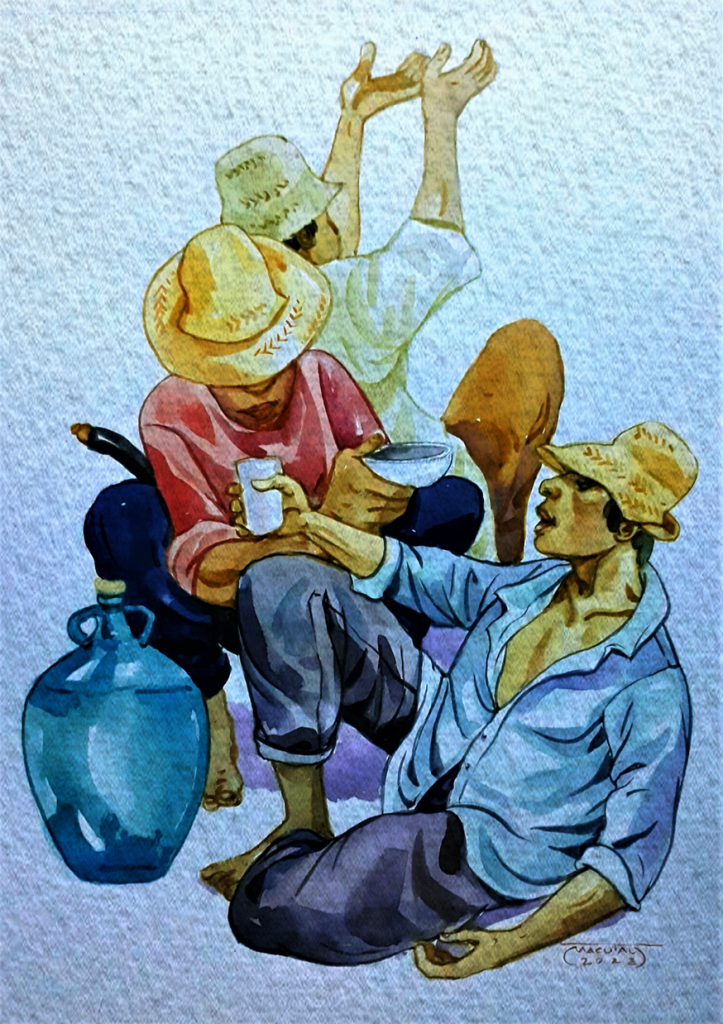By Virgilio C. Ventura
PART 1 of 2.
Drinking alcohol or other intoxicating beverages predates written history by many centuries. Although alcohol has been used therapeutically and medicinally throughout history, its sociocultural significance and subsequent effects on health should not be ignored.
Spanish chroniclers’ written descriptions provide insight into the precolonial drinking culture in the Philippines. The Visayas was where the Spaniards discovered that the people prepared their own drinks and were heavy drinkers, according to Aquino and Persoon (2008:198), and according to Fernandez (2013), “Antonio Pigafetta, Magellan’s chronicler, took note of the tuba, distilled wine from coconut, which he considered to be “stronger and better,” comparing it to Spanish brandy.”1/

Barikan by painter Derrick Macutay, October 6, 2022.2/
Tagay as a Sociocultural Lubricant
Yet, whether distilled or fermented, alcohol consumption is closely associated with socialization and hospitality and thus works best in groups. Drinking’s appeal as a social lubricant is well known as drinkers frequently mention the pleasure it brings from being accepted by a clique (barkada) and being able to momentarily forget all worries that life brings.
The tagay or tagayan (drink/ing) is a unique drinking custom among Filipinos in which the designated tanggero, who fills and distributes drinks to each participating member of the barkada, starts the honorary first drink after discarding the first pour from the bottle (believed to be an offering to the devil). An old Tagalog term “Barik” also means drinking or the act of drinking hence the artist Derrick Macutay’s title for his above artwork is Barikan.
The cost or financial situation of the drinkers affects their choice of alcoholic beverage and setting. While the low income laboring class may choose beer, gin or local drink preparations like tuba (deep orange colored coconut wine made through overnight fermentation high up the coconut trees) or lambanog (a colorless vodka-like beverage made from coconut sap through a process of intense distillation) in front of the house of a barkada member, the wealthy or influential elite clique may prefer foreign-branded whiskey, brandy, tequila, or vodka and hold their drinking sessions in upscale speakeasy or KTV bars.


Likewise, the traditional community service of bayanihan, which involves able-bodied men carrying an entire house structure and moving it for free, is frequently finished off with a tagay, a glass of chaser (fruit juice or cold water), and pulutan (accompanying finger foods like leftovers from a meal or from a fiesta/birthday/wedding celebration like adobo, mechado, sisig, chicharron (fried pork rind), or a can of sardine. It’s a long running gender debate on who prepares pulutan better: men or women? Men will always say they win hands down when it comes to preparing pulutan most especially for food like papaitan (an Ilokano soup dish made of cow or goat innards for where the Tagalog root word pait means bitter – the taste of the extracted juice from the liver) and kilawing tangigue (raw sliced tuna fish marinated with white vinegar and some spices). “Drinking with food also slows down stomach emptying. This may have health benefits by slowing the flux of sugars and fats into the bloodstream and their subsequent burden on the body.”3/
Entertainment can either come in the form of karaoke singing turns or sharing of stories (kuwentuhan). In dire times, the storytelling portion of a tagayan session fills in for the absent pulutan. Work-related pressures and conflicts between office mates are often resolved amicably through “maboteng usapan” (punned term for the Tagalog phrase “mabuting usapan” which means good/calm/friendly talk over bottles (bote) of beer).
Together with the Filipinos’ world-famous talent and hobby for singing (often during karaoke sessions), a tagayan is reflective of our people’s cheerful disposition in life despite the challenges we experience daily. Songs about drinking have been immortalized in Philippine music such as that of the band Parokya ni Edgar’s Inuman Na or of Eraserheads’ Alkohol.
| INUMAN NA Tama na ‘yan, inuman na Hoy, pare ko’y tumagay ka Nananabik na lalamunan Naghihintay, nag-aabang (That’s enough, let’s drinkHey, dude, you drinkThroat’s longing Waiting, expecting) | ALKOHOL Kaya ko pa, kaya pa”, ‘yan ang laging sagot n’ya Nananaginip nang gising, pumupungay ang mata Kaunting alak, nalulunod, lumalakas ang loob Umeekis, gumagapang, natitisod, sumusubsob (“I can do it, still can,” that’s what he always saysDaydreaming, sleepy eyesA little drink, drowning, fearlessCrisscrossing, crawling, stumbling, sinking) |
In contemporary Philippine society, business marketing of certain types or brands has in the recent past transgressed or offended public sensitivities. Remember the Napoleon Quince brandy advertisement “Nakatikim Ka Na Ba ng Kinse Años?” (issue: child molestation) or the Cristine Reyes Colt45 beer promo commercial (issue: women treated as objects)?


(end of Part 1)
NOTES:
1/ Lasco, Gideon, MD, Ph.D., Tagay: Why there’s no Tagalog word for “cheers” and other notes on Filipino drinking culture. Philippine Star, January 6, 2015, citing:
Aquino, D. M., & Persoon, G. A. (2011). TRADITION AND CHANGE: BEER CONSUMPTION IN NORTHEAST LUZON, PHILIPPINES. Liquid Bread: Beer and Brewing in Cross-Cultural Perspective, 7, 197. and Fernandez, D. G. (2013). Historias, Cronicas, Vocabularios: Some Spanish Sources for Research in Philippine Food. Budhi: A Journal of Ideas and Culture, 5(3 6.1), 259-275.
2/ Special thank you note to Mr. Derrick Macutay for graciously producing the artwork Barikan for this article and issue of Health & Lifestyle magazine.
3/ Health Check: does alcohol have medicinal properties? May 19, 2014. https://theconversation.com/health-check-does-alcohol-have-medicinal-properties-25144








